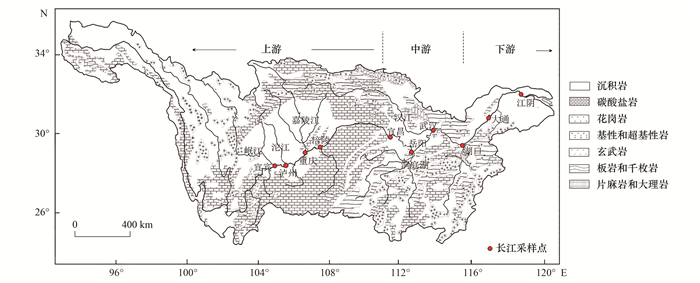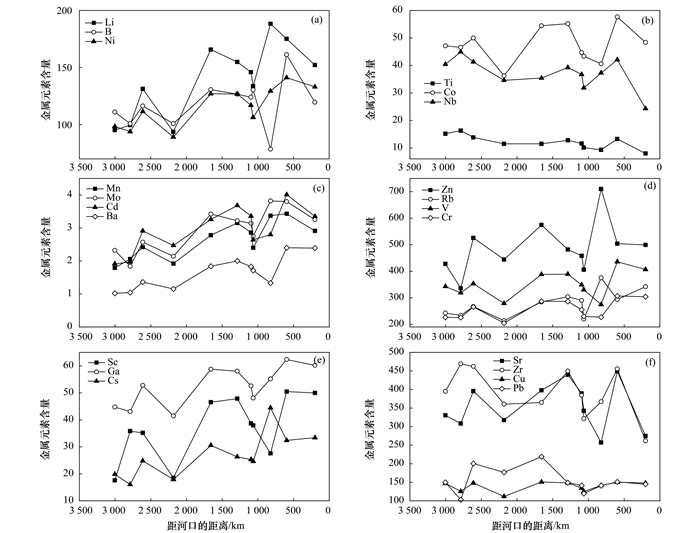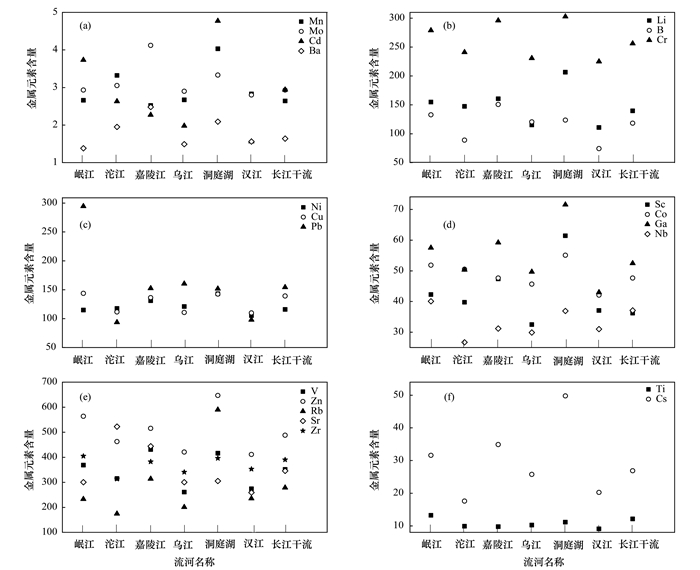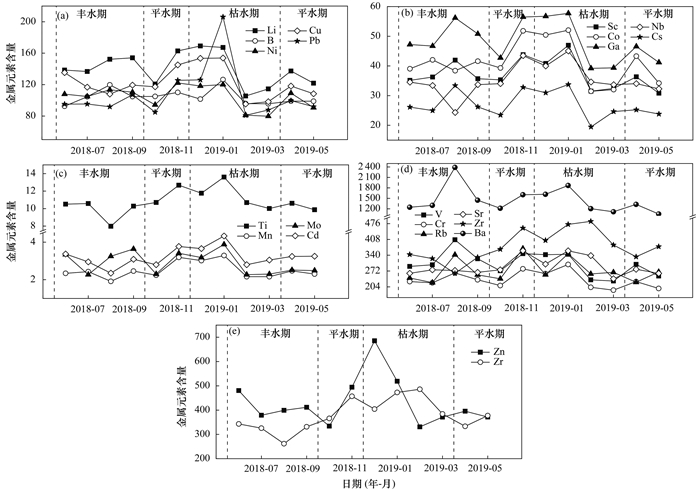2. 青岛海洋科学与技术试点国家实验室, 青岛 266237;
3. 中国海洋大学化学化工学院, 海洋化学理论与工程技术教育部重点实验室, 青岛 266100
2. Pilot National Laboratory for Marine Science and Technology (Qingdao), Qingdao 266237, China;
3. Key Laboratory of Marine Chemistry Theory and Technology, Ministry of Education, College of Chemistry and Chemical Engineering, Ocean University of China, Qingdao 266100, China
河流是连接陆地和海洋的重要纽带, 在陆源物质向海输送中发挥着不可替代的作用[1~4], 并对近海环境产生了重要的影响.河流悬浮颗粒物(suspended particulate matter, SPM)主要来源于土壤侵蚀和岩石风化, 其组成在很大程度上反映了流域气候、生物和岩石(土壤)相互作用的特征, 也是元素由陆地向海输送的重要载体[5, 6].并且由于人类对自然资源的需求量大大增加, 向自然的索取在一定程度上改变了河流原有的自然状态; 工业废水和生产生活废水的排放, 在很大程度上提高了河流水体、颗粒物和沉积物中的元素浓度[7].如, 由于人类生产生活产生的污废水大量排放到河水中, 使得恒河沉积物中的Zn、Cd和Pb等重金属含量在近50年内增加了20% ~30%[8, 9], 这一变化必然会影响SPM中金属元素的输送.同时, 河流携带的大量陆源物质进入陆架边缘海, 对边缘海沉积体系的形成、环境演化和物质循环关键过程的变化具有重要的影响[10].因此, 对河流体系中微量元素地球化学行为的分析有助于获取流域化学风化[11]、气候变化[12~14]和上地壳地球化学组成特征[15], 为河流和海洋体系元素循环过程的研究提供重要信息.此外, 由于物理化学性质的独特性, 重金属元素进入水体后大都迅速与SPM相结合为颗粒态, 在部分河流中甚至有99%以上以颗粒态形式存在的情况[5, 6], 使得溶解态金属元素含量相对较低.更为重要的一点, 重金属元素对生物体毒性大, 难以代谢[16].因此, 了解河流颗粒态重金属元素的输送规律, 还可以评估人类活动干扰下大河流域重金属的污染状况, 识别重金属元素迁移特点[17].
长江是我国第一大河, 具有较高的物质输送通量[18~20].长江流域人类活动强度的增加提高了含金属废水的排放量, 这些进入水体的金属元素在SPM和沉积物之间发生了吸附、解吸、凝聚和累积等一系列物理化学过程, 对水生态环境产生了一定的影响[21, 22].然而, 前人的研究主要聚焦于沉积物和水体溶解态元素[9~11, 17, 18], 而针对颗粒态元素的研究不够深入, 且大多的研究集中在长江的源区、河口区或者某一城市河段[23~28], 这使得人们对长江元素的时空变化规律和影响因素及其对人类活动变化响应的研究存在一定的差距.近年来, 长江流域人类活动强度日益加剧[29, 30], 特别是三峡水库的运行显著改变了长江流域的水文状况, 导致中下游地区的输沙量等水文过程发生了明显变化, 使得水体和沉积物中重金属元素含量较之前有了显著地提高[31].因此, 人类活动对长江中下游颗粒态元素组成具有不可忽视的影响, 而流域过程的变化使得以颗粒物为切入点的研究变得尤为必要.
本研究基于2018年8月在长江干流与主要支流的观测和2018年5月至2019年5月共计13个月在长江下游江阴河段定点综合观测数据, 结合数理统计等方法揭示长江流域颗粒物中金属元素(含准金属元素B, 统称为金属元素, 下同)的时空变化, 评估长江流域中金属元素的来源及其环境影响, 以期为长江环境的综合评估和管理提供科学依据.
1 材料与方法 1.1 流域背景长江发源于青藏高原, 注入黄海和东海, 是世界第三长河.长江水流量存在明显的季节性, 通常在6~10月为丰水期, 水量和沙量较其他时期多.长江一级支流有岷江、沱江、嘉陵江、乌江和汉江, 这些支流水文条件、地质背景和人类活动强度区域性差异较大.长江流域的岩系主要是沉积岩中的碳酸盐岩石、蒸发盐岩石和陆地碎屑沉积岩, 长江北岸流域地区还广泛分布着中酸性火成岩, 伴随着多种金属矿物; 而在南岸则多以沉积岩中的碳酸盐矿物为主; 长江流域地处多个气候带, 气候类型包括高原亚寒带、高原温带、北亚热带和中亚热带等[10].长江上游土地利用类型主要以草地、林地和旱地为主, 中下游则以水田和城镇用地为主[32].
1.2 样品采集2018年8月, 在长江干流、主要支流和入江湖泊(岷江、沱江、嘉陵江、乌江、汉江和洞庭湖干流与支流的交汇处的上游)共16个站位采集水样(图 1); 其中, 10个站位位于长江干流, 6个站位位于长江主要支流和入江湖泊, 采样站位覆盖了长江流域的主要水系.干流采样点多处于水文站附近, 且在邻近城市和干支流交汇处的上游.长江干流最上游端采样站位位于四川省宜宾市(经纬度为104°36′29″E, 28°45′19″N), 距长江入海口3 003 km, 最下游端站位位于江苏省江阴市(经纬度为120°10′55″E, 31°56′17″N), 距长江入海口200 km.在江阴站位进行逐月采样, 用以分析颗粒态元素的月际变化和年入海通量.每站位采水样约5 L, 在现场用孔径为0.45 μm的醋酸纤维滤膜(使用前用0.3%优级纯HCl溶液进行处理, 并清洗至中性)在全玻璃滤器上负压过滤, 滤膜对折后置于洁净的PVC拉链袋中, 并-20℃冷冻保存.

|
修改自文献[33] 图 1 长江干流和支流采样站位示意 Fig. 1 Sampling locations in the Changjiang River |
称取一定量样品(约50 mg, 精度≤0.001 mg), 转移到50 mL聚四氟乙烯消化罐中(用0.3%HCl预洗).加入1 mL浓硝酸和1 mL浓氢氟酸, 放入钢套拧紧后置于烘箱中(190±5)℃加热48 h消解.待样品冷却后用电热板蒸干(115℃), 然后加入1 mL浓硝酸并再次蒸干.加入2 mL 30%的硝酸, 再次转移至聚四氟乙烯消化罐中, 并置于烘箱中于(190±5)℃加热12 h, 将溶解后的样品提取到酸溶液中.最后将样品转移到离心管中用2%硝酸稀释至10 mL.稀释后的样品用于元素分析.分析了Li、B、Sc、V、Cr、Ti、Mn、Co、Ni、Cu、Zn、Ga、Rb、Sr、Zr、Nb、Mo、Cd、Cs、Ba和Pb共21种元素.
元素含量的测定采用电感耦合等离子体质谱仪ICP-MS(Agilent 7900), 基于一系列内标和校准曲线进行, 分析精度约为≤8%, 地质标准分析的相对误差小于5%.为了保证数据的准确性, 样品的分析处理均在同济大学海洋地质国家重点实验室的洁净实验室中进行, 使用的酸均为二次蒸馏提纯后的高纯酸(Sigma-Aldrich Co. LLC, 上海, 中国).另, 现场过滤超纯水作空白膜, 用于扣除空白; 空白样品的其他操作与样品完全相同, 并同样品一起用ICP-MS进行分析.
1.4 数据处理 1.4.1 地累积指数地积累指数法是德国学者Muller[34]提出的定量指标, 可用于评估SPM或沉积物重金属污染的状况, 其计算为:

|
(1) |
式中, Igeoi为某重金属i的地累积指数; Cn和Bn分别为沉积物重金属i的实测值和背景值(g ·kg-1或mg ·kg-1); k为考虑人类活动和自然风化过程引起的重金属背景值变动的系数, 取值为1.5(无量纲).地累积指数可将颗粒物中重金属的污染等级分为:无污染(≤0)、轻度污染(0~1)、偏中度污染(1~2)、中度污染(2~3)、偏重污染(3~4)、重污染(4~5)和严重污染(>5)[35~37].
1.4.2 元素入海通量根据月径流量、各月份SPM浓度和各元素的含量, 选择长江下游的江阴站位, 对长江颗粒态金属元素的年入海通量进行计算(时间段为5月至次年4月), 计算公式如下:

|
(2) |
式中, cSPM为SPM浓度(mg ·L-1), Ji为元素入海通量(t ·a-1), Ci为各元素的含量(mg ·kg-1), Q为径流量(m3 ·month-1), t为不同单位之间的转换系数(10-3 t ·mg-1), n为12.通过计算颗粒态金属元素的年入海通量, 并与溶解态金属元素的入海通量[38]进行对比, 以综合反映长江各元素输送规律.
通量的相对误差(δ)根据傅里叶级数[39]计算如下:

|
(3) |
式中, n为一年内样品数, Qi为月流量, Qa为年平均流量, ci为SPM浓度(mg ·L-1)或各元素含量(mg ·kg-1), ca为SPM浓度(mg ·L-1)或各元素含量的年平均值(mg ·kg-1).
1.5 统计分析利用相关性分析和主成分分析揭示元素的来源和控制因素; 采用Pearson相关系数确定不同元素间的相关关系, 将相关性较显著的元素归为同一来源; 主成分分析法对变量进行降维, 进而对元素来源信息进行提取[40~42].统计分析均使用SPSS 26统计软件完成.
2 结果与讨论 2.1 长江干流金属元素的空间变化 2.1.1 悬浮颗粒物浓度和空间变化长江干流SPM在上游浓度较中下游高, 在重庆至宜昌河段浓度迅速下降, 并在宜昌河段出现最低值[图 2(a)]; 在中游SPM浓度逐渐增加, 而在下游浓度又有所降低.除侵蚀外, 上游SPM浓度高主要是由于长江上游落差大, 水流湍急, 水体携沙能力强, 且河水对河床以及河流两岸的冲刷作用也较强.由于三峡大坝的滞留作用, 导致三峡水库河段泥沙沉降加快, 江水中SPM浓度随之降低, 泥沙滞留和清水下泄使得在水库和三峡大坝之下的宜昌河段保持着较低的泥沙含量.之后, 由于清水对宜昌以下河床的侵蚀作用, SPM浓度逐渐升高.到了长江下游, 地势变得相对平缓, 较小的落差使得水流速减缓, SPM因沉降作用浓度再次降低.由于河流系统的SPM浓度和水动力条件等密切相关[43], 长江输送的SPM在丰水期具有较高的浓度[图 2(b)], 且与水的流速和流量呈正相关关系, 并显著影响了其通量的季节变化[44, 45].

|
(a)干流SPM浓度沿程变化; (b)下游江阴河段逐月变化 图 2 长江SPM浓度变化 Fig. 2 Change in SPM concentration in the Changjiang River |
在所观测元素中, Ti、Mn和Ba的含量明显高于其他元素, 流域平均值分别为12.1、2.55和1.64 g ·kg-1; Zn、Zr、V、Sr、Rb、Cr、Pb、Li、Cu、B、Ni、Ga、Co、Nb、Sc和Cs等元素的含量在所测元素含量范围中处于中等水平, 其平均值介于20~400 mg ·kg-1之间; Mo和Cd含量最低, 分别为2.93 mg ·kg-1和2.85 mg ·kg-1.
Ti、Sr、Zr、Co、Cu、Nb和Pb等元素在上游含量的平均值高于其下游, 含量最大值依次为16.3 g ·kg-1、44.9 mg ·kg-1、462.1 mg ·kg-1、448.7 mg ·kg-1、57.7 mg ·kg-1、150.1 mg ·kg-1和225.8 mg ·kg-1, 且大多在重庆河段出现高值, 仅Ti和Nb最大值出现在泸州河段; 各元素含量总体沿水流方向呈现波动下降趋势[图 3(e)和3(f)], 说明沿程有元素迁出.在宜昌河段元素含量略有增加, 沿水流方向又呈现下降趋势, 大多元素在湖口出现低值.Ti、Sr、Zr、Co、Cu、Nb和Pb在上游含量较高, 很大程度上与较强的矿产开发[46]和重庆较高的人类活动[47]有关.

|
Ti、Mn和Ba含量单位为g ·kg-1, 其余元素含量单位均为mg ·kg-1 图 3 长江干流颗粒态元素的空间分布 Fig. 3 Spatial distribution of particulate elements in the Changjiang River |
总体上, Li、B、Sc、Mn、Ni、Zn、Ga、Rb、Mo、Cd、Cs和Ba等元素沿水流方向呈波动上升趋势[图 3(a)~3(d)], 说明沿程有元素输入过程, 这些元素均在重庆河段出现一个高值, 之后在涪陵河段元素含量迅速降低, 并出现较低值.Li、Zn、Rb和Cs的最大值出现在湖口站位, 其含量分别为188.4、710.4、375.2和44.7 mg ·kg-1, 其余元素均在大通河段出现最大值.
沿水流方向, V和Cr呈下降趋势, 使其上游的含量平均值要低于下游, 含量最大值均出现在大通站位, 分别为435.5 mg ·kg-1和306.9 mg ·kg-1.与之相似, Sr、Co和Cu的最大值也出现在大通河段[图 3(b)和3(f)], 可能与下游人为输入有关.
B、Ba、Co、Cd、Cr、Ni、Sc、Sr、Ti和V等元素在湖口站位出现一个低值.从宜宾至湖口河段蜿蜒曲折, 河床宽且水流缓慢[48], 有利于沉积物发生吸附沉降作用.因此, 在长江中游河段, 沿着水流方向多数元素含量逐渐下降, 并在湖口出现一个相对低值.
在长江上游, 几乎所有元素含量都自涪陵河段出现下降趋势, 这很大程度上是由于河水进入三峡水库后流速减慢, SPM浓度因沉降作用随之减少.此时, 多数元素随着颗粒物一起沉降到沉积物中.此外, 乌江在涪陵汇入长江后产生的稀释作用也会使库区中SPM浓度降低.在大坝之下的宜昌, 随着上游清水的下泄, 在长江中游产生了河床的侵蚀, 使得底部的沉积物再悬浮, 导致其携带元素含量上升.在长江下游部分元素含量的上升, 如湖口和大通的高值, 与人类活动强度影响较中上游增加有关.
2.2 长江支流元素含量的空间变化岷江、沱江、嘉陵江、乌江、汉江和洞庭湖金属元素平均值与长江干流的对比如图 4所示.在长江上游的岷江Cu、Nb、Rb、Sr和Ti等元素含量略低于干流, 其他元素含量均高于干流, 其中Mn的含量为2.66 g ·kg-1, 达到干流的1.5倍, Cd和Pb的含量分别为3.73 mg ·kg-1和294.3 mg ·kg-1, 大致为干流含量的2倍. 沱江的元素含量和邻近的岷江有所不同, Li、Sc、Mn、Co、Ni、Sr、Mo和Ba等元素含量略高于干流平均值, 其他元素含量均低于干流平均值.岷江和沱江流域主要位于四川省境内, 流经成都、乐山和宜宾等人口密集的城市[49], 受到生活污水排放的影响.此外, 在这些区域沿岸地区蕴藏丰富的矿产资源, 部分矿渣和废渣引起了河道周围的土壤污染, 在雨水冲刷和淋溶作用下一定量的金属元素缓慢流入到河水中, 导致其水体和沉积物中金属元素的含量也呈现出逐渐升高的趋势[50~52], 高含量的Mn、Cd、Pb和Zn等重金属元素, 也从侧面证实了人类活动对岷江和沱江金属元素来源的影响.

|
Ti、Mn和Ba含量单位为g ·kg-1, 其余元素含量单位均为mg ·kg-1 图 4 长江支流元素含量与干流含量的对比 Fig. 4 Element concentrations of tributary and main stream in the Changjiang River |
嘉陵江颗粒物中Ti、Mn、Zr、Nb和Cd略低于干流平均值, 其他元素的含量均高于干流平均值, 这主要是流域内地质背景和人类活动综合作用的结果.嘉陵江位于长江上游北岸, 在其流域内广泛分布着Fe、Cu、Pb、Zn、Hg、Sb、Sn、Ni和Mo等金属矿藏以及铝土矿和非金属煤矿藏.近年来伴随着当地开采量的不断增加, 部分矿区的尾矿和废石经过雨水冲刷浸泡, 使携带有大量金属元素的颗粒物进入河流中.由于工矿业不断发展, 嘉陵江两岸产生的废水废渣中携带有部分金属元素, 使得如Pb、Zn、Cd、Ni和Cu等重金属进入水体中, 加剧了河流污染[53].陈鹏飞[54]的研究发现, 流域沿岸的土壤和沉积物中的部分金属累积量表现出高度的相关性, 这表明河流中的部分金属元素很有可能是矿区周围富含金属元素的土壤在河水和降雨的冲刷作用下进入河流, 或被SPM吸附后沉积, 或沿水流方向向下游输送.此外, 在岷江和嘉陵江流域有大量的煤矿、钢铁和钒钛工业产业园区, 这些矿产的开采活动也会引起长江支流中V、Mn、Ti和Fe等元素的大量富集[55].
汉江位于干流北岸, 是长江中游最大的支流[56, 57].除Sc和Mn外, 在汉江所测的大多数元素含量相对于其他北岸3条支流而言较低, 且低于干流平均值, 这可能与在汉江修建的丹江口水库对颗粒物的滞留作用有关, 导致汉江站位SPM中金属元素含量较低.
对于地处干流南岸的乌江而言, 几乎所有的元素含量均低于其他北岸的4条支流, 这不仅与乌江梯级水库对颗粒物的滞留有关, 也与其流域的地质背景密切相关.长江北岸流域地区大多以中酸性火成岩为主, 伴随着多种金属矿藏, 如Mn、Cu、Pb、Zn、Ti、V、Cr、Co和Ni等矿产.Li、Nb和Sc是典型的亲石元素, 在中酸性岩中含量较高[58, 59], 这就使得在自然风化的过程中北岸支流中金属元素的含量要明显高于南岸支流.而长江南岸流域则多以碎屑碳酸盐矿物(主要为方解石和白云石)为主[10], 岩石中金属含量相对中酸性火成岩较低.
Cr、Mn、Co、Ni、Cu、Zn和Cd等重金属元素均在中游的洞庭湖站位出现最大值, 这主要受人类活动影响.洞庭湖周边金属矿区分布广泛, 导致大量的金属元素被支流携带入湖; 另一方面, 湖区周边建有诸如造纸、船舶等企业, 在生产过程中有大量废水废物排进湖中, 提高了洞庭湖颗粒物中重金属的含量[60~62].与之不同, Pb的最大值出现在上游的岷江河段, 这应该与该区域以煤为主的能源结构有关.
2.3 长江下游金属元素时间变化和入海通量 2.3.1 时间变化从图 5中可以看出, 各颗粒态元素含量的变化趋势大致相同, 均在枯水期(12月至次年3月)出现高值, 而在丰水期含量相对较低.在枯水期河流流量小, 水体冲刷作用弱, 粒径较粗的颗粒物沉降至沉积物中, 导致水体中细颗粒物占比较多, 这部分颗粒物具有较高的吸附能力, 从而增加了水体颗粒物中金属元素的含量.在丰水期, 特别是降雨较为集中的时段, 流域土壤侵蚀和河床冲刷作用均较其他时期增强, 使得水体颗粒物增多, 有利于颗粒物对金属元素的吸附[63, 64]; 不过, 丰水期粗颗粒物的增加稀释了颗粒物中各元素的含量, 导致丰水期各元素的含量相对其他时期较低.10月各元素含量的降低很大程度上是由于三峡水库等集中蓄水导致的颗粒物输送通量的减少所致(图 5).

|
Ti和Mn含量单位为g ·kg-1, 其余元素含量单位均为mg ·kg-1 图 5 江阴河段重金属元素时间变化 Fig. 5 Seasonal variation in metal elements at Jiangyin station in the Changjiang River |
长江下游江阴河段距河口200 km, 可以代表长江元素入海的整体特征.由公式(2) 可知, 受流域风化控制的金属元素中, Ti、Sc、Zr和Nb的年入海通量平均值分别为1.05×106、892、907和834 t ·a-1, 其中Ti的入海通量明显高于其他元素, 其原因主要是Ti在地壳中的丰度显著高于其他元素.
河流SPM所携带的主要污染元素的通量平均值从大到小为: Mn、Zn、Cr、Cu、Pb、Ni、Co和Cd, 年入海通量分别为: 5.9×105、10 100、5 610、2 900、2 590、2 480、99和75 t ·a-1, 其中, Pb和Zn的通量相较于文献[65]有不同程度的增长, 分别增长了24%和6.9%, 而Cd的入海通量则下降了58%, 说明长江流域内的Pb和Zn污染有加重的趋势.与溶解态元素[44]相比, 颗粒态元素的入海通量显著高于溶解态, 其中颗粒态Mn和Pb年入海通量分别是溶解态的612倍和19倍, 说明从河流向海输送的重金属元素中颗粒态元素占优势地位, 这些元素的入海可能成为长江口及邻近海域的主要重金属污染物的来源[66].尽管各颗粒态元素在丰水期的含量要低于枯水期, 但元素入海通量的峰值出现在丰水期, 占长江年通量的39.8% ~56.4%, 这与丰水期流量远高于枯水期有关.根据公式(3)可知, 长江SPM及各元素入海通量误差介于-9% ~10%之间.
2.3.3 与世界其他河流的比较对比全球其他河流(表 1), 长江重金属元素含量高于受人类活动影响较小的河流, 如亚马逊河(Amazon River); 但仍低于工、农业和采矿业发达的河流, 如泰国湄公河(Mekong River)、欧洲多瑙河(Daube River)、意大利波河(Po River) 和德国易北河(Elbe River)等河流[67~71].在长江, 重金属元素受人类活动影响显著, 含量最大值多出现在下游区域, 且高于世界河流平均值, 表明重金属元素来源集中在工、农业发达的中下游区域.由于长江流域火成岩分布较广[72], 长江颗粒物中铁族和亲铜元素含量因此较高, 导致Ti、Mn、V、Ni、Cu、Pb和Zn等元素的背景值也高于我国的黄河[73].
|
|
表 1 与世界其他大河重金属元素的对比1)/mg ·kg-1 Table 1 Comparison of the heavy metal elements for the major rivers in the world/mg ·kg-1 |
2.4 长江金属元素的来源和控制因素
长江流域内SPM中元素含量的变化趋势是不同地带性的气候条件所决定的风化和成土过程综合作用的结果, 并由于地球化学迁移能力的不同产生了区域性的差异[51].如, Ti、Mn和Ba这3种元素的丰度在地壳中元素丰度的排名分别为9、12和14, 具有较高的元素丰度.因此, 这些元素含量相对于其他元素显著偏高, 这显然与长江流域的岩石组成和风化作用有关[74].此外, 由于长江上游河段受蒸发盐岩溶解作用的影响显著高于中下游河段, 而下游河段又以碳酸岩影响为主, 这便使得Li在上游的含量低于下游[75]. Li、Rb和Cs属于同族元素, 地球化学性质相似, 因此其空间变化趋势大致相同.
除Li、Mo、Pb、Ti和Zn等元素外, 在人口密度大的下游地区(如大通和江阴段), 多个元素含量均出现明显的高值, 这主要受人类活动强度和地形与地貌变化的影响.一般而言, 长江下游具有较上游高的城市化进程和农业活动, 这无疑会增加元素向河的输送.另外, 在长江中上游多以山川和丘陵为主, 水流湍急; 在下游多为平原地区为主, 水流较长江上游变缓, 致使较大粒径的SPM易在下游发生沉降, 而粒径较小的颗粒物更易吸附水体中的金属元素, 导致下游颗粒态中部分金属元素含量出现高值.
对长江干流各元素进行主成分分析, 根据特征向量选取准则(特征值>1.0)共提取4个主成分, 通常认为大于0.3的因子是重要的[76].主成分分析显示这4个主成分可以解释原始变量的95.2%, 其中第一主成分占解释变量的54.7%, 可用于指示长江SPM中元素的来源.第一主成分主要代表工业、金属冶炼和矿物开采等工业污染来源, 相关元素分别是Mn、Cu、Zn、Ni和Cd等重金属元素, 如Cu和Zn通常作为金属工业发展的指标[77], Cd和Ni多用于指示工业污染程度的指标[78].第二主成分的高载荷主要包括B、Sc、V、Cr、Mn、Co、Ni、Cu、Ga、Sr、Mo、Cd和Ba, 其中B、Sc、Ga和Sr主要来源于土壤侵蚀和岩石风化, 而Co、Ni、Cu和Cd主要是由人类活动产生, 因此第二主成分代表了地壳来源和人类活动混合来源.第三主成分被认为是地壳来源, 包括岩石的风化、土壤的侵蚀和矿物的溶解等, 在这一成分中高载荷元素主要有Ti、Sc、Zr和Nb等, 这些元素在环境中非常稳定, 在表生环境中可代表岩石和矿物的来源[79, 80].第四主成分主要代表了大气沉降, 其来源主要有汽车尾气的排放和化石燃料的燃烧, 相关元素包括高载荷的Pb和中等载荷的Zn和Cu.大气颗粒物中Zn被认为主要是交通工具的排放, 而Pb的来源可能还与煤的燃烧有关.因此, 交通工具的排放和燃煤释放被认识是长江流域大气沉降中Zn和Pb的主要来源[81].
值得一提的是, Li、Cr、Mn、Ni、Ga、Mo、Cd和Ba同时出现在了第一和第二主成分中, Sc和Co同时出现在第二和第三主成分中, Cu则同时出现在4个主成分中, 这进一步说明在长江干流SPM中元素的迁入和迁出并不是由单一过程控制, 而是多个过程综合作用的结果.
相关分析与上述主成分分析的结果相一致(图 6).Mn、Cu、Zn、Ni和Cd等重金属元素显著相关(P < 0.01), 说明它们的地球化学行为以及来源方面存在一定的共性.B、Sc和Ga两两之间显著相关(P < 0.01), Ti、Zr和Nb三者也在0.01水平上显著相关, 说明它们各组的来源一致.Cu、Zn和Pb三者之间存在较为显著的相关性, 表明大气沉降对其来源的影响不容忽视; 不过, Cu、Zn和Pb元素较其它元素的相关性稍弱, 从一个侧面表明三者受到了诸如工业和农业等人类活动的共同影响.

|
*表示P≤0.05, **表示P≤0.01 图 6 长江干支流元素相关性分析 Fig. 6 Correlation analysis of the metal elements of the Changjiang River |
同样, 对长江下游江阴河段丰水期、平水期和枯水期进行主成分分析, 每个时期均提取到2个主成分.不过, 这3个时期每个主成分所代表的含义却有所不同.在丰水期, 主成分1代表自然来源, 其高载荷元素包括B、Sc、Ti、V、Ga、Rb、Sr、Zr、Nb、Cs和Ba等; 主成分2则代表了人类活动, 其高载荷元素包括Cr、Mn、Co、Ni、Cu、Zn、Cd和Pb等重金属元素.在平水期和枯水期, 主成分1则代表人类活动, 主成分2代表自然来源.两个时期主成分和高载荷元素的不同说明在不同时期控制长江下游元素来源的因素不同.丰水期水流量大、流域侵蚀作用强, 自然因素成为主要的控制因素; 平水期和枯水期水流量偏低, 对污染物的稀释作用弱, 人为因素成为控制颗粒物中元素的主要因素.
2.5 长江流域重金属污染状况及环境意义Zn、Pb、Cu、Cr、Cd、Co、Mn和Ni等元素被认为是河流水体中的主要重金属污染元素[82].因此, 研究SPM中重金属的行为可以更好地认识重金属的迁移规律, 并指示其污染程度[6].由于针对颗粒态重金属污染的评价方法较少, 因此借鉴沉积物重金属污染评价使用的地累积指数法[83]计算SPM中重金属元素的污染特征(图 7).

|
图 7 长江重金属元素的地累积指数值 Fig. 7 Cumulative index values of heavy metal elements of the Changjiang River |
从图 7可以看出, 在长江流域Cd的地累积指数均大于4, 属于重污染, 在大通河段甚至达到了5.1, 属于严重污染.Cr、Co和Ni的地累积指数均在1~2之间, 属于偏中度污染.Mn元素在大通和湖口两个站位的地累积指数大于2, 属于中度污染.在其他站位的值在1~2之间, 属于偏中度污染.大多数站位Cu、Zn和Pb的地累积指数值大于2, 属于中度污染.同样, 在下游江阴河段上述重金属也呈现污染的特征, 特别是在枯水期.可见, 大多重金属处于偏中度污染或中度污染, Cd属于重度污染; 相比于世界其他河流, 长江Cd的含量也较高(表 1).相对于水体中较低的溶解态的元素含量而言[38], 长江颗粒态重金属的含量普遍较高, 呈现受污染的趋势, 尤其是Cd.由于SPM具有较大的表面积和较强的吸附性, 使得SPM中金属元素的含量往往高于水体和沉积物, 是水环境中重金属潜在的源.因此, 要加强对长江流域颗粒物中的各元素的迁移和污染状况的认识, 综合考虑金属元素的来源、时空变化和对近海的影响, 以有效地保护长江水质环境和生态系统的稳定.今后, 要加强上游采矿废水、废渣和下游工业废水排放的监管和控制, 特别是在重庆和武汉等人口密集的城市.
3 结论(1) 在长江干流, Mn、Cu、Zn、Ni、Co、Pb、Cd和Cr等元素主要受人类活动影响, 其中Pb主要来源于煤炭、石油等化石燃料燃烧后的大气沉降, 其余重金属元素主要来源于工业生产和矿业开采等.B、Sc、Ga、Sr、Ti、Zr和Nb等元素主要来源于岩石风化和土壤侵蚀等自然原因.Ti、Mn和Ba 3种元素的含量远高于其他元素, 可能与长江流域的岩石的背景值有关.南岸支流(乌江)各元素含量明显低于北岸支流(岷江、沱江、嘉陵江和汉江), 这主要与地质背景和气候条件差异有关.
(2) 长江各观测元素入海通量介于75~5.9×105 t ·a-1, 在丰水期的通量占年度的39.8% ~56.4%, 且颗粒态元素输送通量远高于其溶解态.在丰水期颗粒态金属元素主要受自然过程控制, 而在平水期和枯水期主要受人类活动影响.长江SPM中Cr、Co、Ni和Mn属于偏中度污染, Cu、Zn和Pb属于中度污染, Cd属于重度污染.长江相对于全球的河流而言处于中等污染水平.
致谢: 感谢同济大学海洋地质国家重点实验室在数据分析方面的支持!采样工作得到了长江沿线水文站和海事码头等单位的大力支持, 在此一并表示感谢!
| [1] | Chalov S R, Liu S G, Chalov R S, et al. Environmental and human impacts on sediment transport of the largest Asian rivers of Russia and China[J]. Environmental Earth Sciences, 2018, 77(7). DOI:10.1007/s12665-018-7448-9 |
| [2] |
辛成林, 任景玲, 张桂玲, 等. 黄河下游水体悬浮颗粒物中金属元素的地球化学行为[J]. 中国环境科学, 2015, 35(10): 3127-3134. Xin C L, Ren J L, Zhang G L, et al. Geochemistry of metals in the suspended particles in the lower reach of the Huanghe[J]. China Environmental Science, 2015, 35(10): 3127-3134. DOI:10.3969/j.issn.1000-6923.2015.10.033 |
| [3] |
张朝生, 王立军, 章申. 长江中下游河流沉积物和悬浮物中金属元素的形态特征[J]. 中国环境科学, 1995, 15(5): 342-347. Zhang C S, Wang L J, Zhang S. Metal speciation in sediments and suspended matter in the middle-lower reaches of the Changjiang River[J]. China Environmental Science, 1995, 15(5): 342-347. DOI:10.3321/j.issn:1000-6923.1995.05.011 |
| [4] | Huang S J, Wei J, Chen Q W, et al. Investigation on heavy metal pollution risk of sediment in a human-disturbed river, China[J]. IOP Conference Series: Earth and Environmental Science, 2019, 281. DOI:10.1088/1755-1315/281/1/012009 |
| [5] | Chalov S, Moreido V, Sharapova E, et al. Hydrodynamic controls of particulate metals partitioning along the lower Selenga River—Main tributary of the Lake Baikal[J]. Water, 2020, 12(5). DOI:10.3390/w12051345 |
| [6] | Song Y X, Ji J F, Mao C P, et al. Heavy metal contamination in suspended solids of Changjiang River—environmental implications[J]. Geoderma, 2010, 159(3-4): 286-295. DOI:10.1016/j.geoderma.2010.07.020 |
| [7] | Chetty S, Pillay L. Assessing the influence of human activities on river health: a case for two South African rivers with differing pollutant sources[J]. Environmental Monitoring and Assessment, 2019, 191(3). DOI:10.1007/s10661-019-7308-4 |
| [8] | Maurya P K, Malik D S. Bioaccumulation of heavy metals in tissues of selected fish species from Ganga River, India, and risk assessment for human health[J]. Human and Ecological Risk Assessment: An International Journal, 2019, 25(4): 905-923. DOI:10.1080/10807039.2018.1456897 |
| [9] | Verma K, Pandey J. Heavy metal accumulation in surface sediments of the Ganga River (India): speciation, fractionation, toxicity, and risk assessment[J]. Environmental Monitoring and Assessment, 2019, 191(7). DOI:10.1007/s10661-019-7552-7 |
| [10] |
丁悌平, 高建飞, 石国钰, 等. 长江水中悬浮物含量与矿物和化学组成及其地质环境意义[J]. 地质学报, 2013, 87(5): 634-660. Ding T P, Gao J F, Shi G Y, et al. The contents and mineral and chemical compositions of suspended particulate materials in the Yangtze River, and their geological and environmental implications[J]. Acta Geologica Sinica, 2013, 87(5): 634-660. DOI:10.3969/j.issn.0001-5717.2013.05.004 |
| [11] | Kaotekwar A B, Ahmad S M, Satyanarayanan M, et al. Geochemical investigations in bulk and clay size fractions from lower Krishna River sediments, southern India: implications of elemental fractionation during weathering, transportation and deposition[J]. Geosciences Journal, 2019, 23(6): 951-960. DOI:10.1007/s12303-019-0002-2 |
| [12] | Cao Z G, Duan H T, Feng L, et al. Climate- and human-induced changes in suspended particulate matter over Lake Hongze on short and long timescales[J]. Remote Sensing of Environment, 2017, 192: 98-113. DOI:10.1016/j.rse.2017.02.007 |
| [13] | Johnson E R, Inamdar S, Kan J, et al. Particulate organic matter composition in stream runoff following large storms: Role of POM sources, particle size, and event characteristics[J]. Journal of Geophysical Research: Biogeosciences, 2018, 123(2): 660-675. DOI:10.1002/2017JG004249 |
| [14] | Okuku E O, Tole M, Bouillon S. Role of a cascade of reservoirs in regulating downstream transport of sediment, carbon and nutrients: case study of tropical arid climate Tana River Basin[J]. Lakes & Reservoirs: Science, Policy and Management for Sustainable Use, 2018, 23(1): 43-55. |
| [15] | Lipp A G, Shorttle O, Syvret F, et al. Major element composition of sediments in terms of weathering and provenance: implications for crustal recycling[J]. Geochemistry, Geophysics, Geosystems, 2020, 21(6). DOI:10.1029/2019GC008758 |
| [16] |
霍文毅, 黄风茹, 陈静生, 等. 河流颗粒物重金属污染评价方法比较研究[J]. 地理科学, 1997, 17(1): 81-86. Huo W Y, Huang F R, Chen J S, et al. Comparative study of assessment method for river particulate heavy metal pollution[J]. Scientia Geographica Sinica, 1997, 17(1): 81-86. DOI:10.13249/j.cnki.sgs.1997.01.012 |
| [17] | Wang J, Liu G N, Wu H, et al. Temporal-spatial variation and partitioning of dissolved and particulate heavy metal(loid)s in a river affected by mining activities in Southern China[J]. Environmental Science and Pollution Research International, 2018, 25(10): 9828-9839. DOI:10.1007/s11356-018-1322-x |
| [18] | Guo J H, Wang F S, Vogt R D, et al. Anthropogenically enhanced chemical weathering and carbon evasion in the Yangtze Basin[J]. Scientific Reports, 2015, 5. DOI:10.1038/srep11941 |
| [19] | Qin T, Yang P H, Groves C, et al. Natural and anthropogenic factors affecting geochemistry of the Jialing and Yangtze Rivers in urban Chongqing, SW China[J]. Applied Geochemistry, 2018, 98: 448-458. DOI:10.1016/j.apgeochem.2018.10.009 |
| [20] | Zhang L K, Qin X Q, Huang Q B, et al. Role of sulfuric acid in chemical weathering of carbonate rocks for evaluating of carbon sinks in the Yangtze River Basin, China[J]. E3S Web of Conferences, 2019, 98. DOI:10.1051/e3sconf/20199806015 |
| [21] | López A D F, Truchet D M, Rimondino G N, et al. Microplastics and suspended particles in a strongly impacted coastal environment: Composition, abundance, surface texture, and interaction with metal ions[J]. Science of the Total Environment, 2021, 754. DOI:10.1016/j.scitotenv.2020.142413 |
| [22] | Tsompanoglou K, Anagnostou C, Krasakopoulou E, et al. Distribution and geochemical composition of suspended particulate material in the shallow embayment of northern Thermaikos Gulf, Greece[J]. Continental Shelf Research, 2017, 143: 295-310. DOI:10.1016/j.csr.2017.05.002 |
| [23] | Yin S, Wu Y H, Xu W, et al. Contribution of the upper river, the estuarine region, and the adjacent sea to the heavy metal pollution in the Yangtze Estuary[J]. Chemosphere, 2016, 155: 564-572. DOI:10.1016/j.chemosphere.2016.04.095 |
| [24] |
邵秘华, 王正方. 长江口海域悬浮颗粒物中铜、铅、镉的化学形态及分布特征研究[J]. 海洋与湖沼, 1992, 23(2): 144-149. Shao M H, Wang Z F. A study on the distributive characteristics of chemical form of Cu, Pb and Cd in suspended particulate in Chang Jiang River estuary[J]. Oceanologia et Limnologia Sinica, 1992, 23(2): 144-149. |
| [25] |
盛菊江, 范德江, 杨东方, 等. 长江口及其邻近海域沉积物重金属分布特征和环境质量评价[J]. 环境科学, 2008, 29(9): 2405-2412. Sheng J J, Fan D J, Yang D F, et al. Distribution patterns of heavy metals in surface sediments of the Yangtze Estuary and its adjacent areas and environmental quality assessment[J]. Environmental Science, 2008, 29(9): 2405-2412. DOI:10.3321/j.issn:0250-3301.2008.09.004 |
| [26] | Liu M, Chen J B, Sun X S, et al. Accumulation and transformation of heavy metals in surface sediments from the Yangtze River estuary to the East China Sea shelf[J]. Environmental Pollution, 2019, 245: 111-121. DOI:10.1016/j.envpol.2018.10.128 |
| [27] | Wang X, Liu B L, Zhang W S. Distribution and risk analysis of heavy metals in sediments from the Yangtze River Estuary, China[J]. Environmental Science and Pollution Research International, 2020, 27(10): 10802-10810. DOI:10.1007/s11356-019-07581-x |
| [28] | Fan H M, Chen S S, Li Z E, et al. Assessment of heavy metals in water, sediment and shellfish organisms in typical areas of the Yangtze River Estuary, China[J]. Marine Pollution Bulletin, 2020, 151. DOI:10.1016/j.marpolbul.2019.110864 |
| [29] | Wan M X, Hu W Y, Wang H F, et al. Comprehensive assessment of heavy metal risk in soil-crop systems along the Yangtze River in Nanjing, Southeast China[J]. Science of the Total Environment, 2021, 780. DOI:10.1016/j.scitotenv.2021.146567 |
| [30] | Luo M K, Yu H, Liu Q, et al. Effect of river-lake connectivity on heavy metal diffusion and source identification of heavy metals in the middle and lower reaches of the Yangtze River[J]. Journal of Hazardous Materials, 2021, 416. DOI:10.1016/j.jhazmat.2021.125818 |
| [31] |
张朝生, 章申, 何建邦. 长江水系沉积物重金属含量空间分布特征研究——地统计学方法[J]. 地理学报, 1997, 52(2): 184-192. Zhang C S, Zhang S, He J B. Spatial distribution characteristics of heavy metals in the sediments of Changjiang River system——geostatistics method[J]. Acta Geographica Sinica, 1997, 52(2): 184-192. DOI:10.3321/j.issn:0375-5444.1997.02.014 |
| [32] |
徐苏, 张永勇, 窦明, 等. 长江流域土地利用时空变化特征及其径流效应[J]. 地理科学进展, 2017, 36(4): 426-436. Xu S, Zhang Y Y, Dou M, et al. Spatial distribution of land use change in the Yangtze River Basin and the impact on runoff[J]. Progress in Geography, 2017, 36(4): 426-436. |
| [33] | Wang X D, Yang S Y, Ran X B, et al. Response of the Changjiang (Yangtze River) water chemistry to the impoundment of Three Gorges Dam during 2010-2011[J]. Chemical Geology, 2018, 487: 1-11. DOI:10.1016/j.chemgeo.2018.04.006 |
| [34] | Muller G. Index of geoaccumulation in sediments of the Rhine river[J]. Geo Journal, 1969, 2(3): 108-118. |
| [35] | Addo-Bediako A, Nukeri S, Kekana M. Heavy metal and metalloid contamination in the sediments of the Spekboom River, South Africa[J]. Applied Water Science, 2021, 11(7). DOI:10.1007/S13201-021-01464-8 |
| [36] | Singovszka E, Balintova M. Enrichment factor and geo-accumulation index of trace metals in sediments in the river Hornad, Slovakia[J]. IOP Conference Series: Earth and Environmental Science, 2019, 222. DOI:10.1088/1755-1315/222/1/012023 |
| [37] | Teixeira R A, de Souza E S, de Lima M W, et al. Index of geoaccumulation and spatial distribution of potentially toxic elements in the Serra Pelada gold mine[J]. Journal of Soils and Sediments, 2019, 19(7): 2934-2945. DOI:10.1007/s11368-019-02257-y |
| [38] |
吴文涛, 冉祥滨, 李景喜, 等. 长江水体常量和微量元素的来源、分布与向海输送[J]. 环境科学, 2019, 40(11): 4900-4913. Wu W T, Ran X B, Li J X, et al. Sources, distribution, and fluxes of major and trace elements in the Yangtze River[J]. Environmental Science, 2019, 40(11): 4900-4913. DOI:10.13227/j.hjkx.201903134 |
| [39] |
熊秋林, 赵文吉, 郭逍宇, 等. 北京城区冬季降尘微量元素分布特征及来源分析[J]. 环境科学, 2015, 36(8): 2735-2742. Xiong Q L, Zhao W J, Guo X Y, et al. Distribution characteristics and source analysis of dustfall trace elements during winter in Beijing[J]. Environmental Science, 2015, 36(8): 2735-2742. DOI:10.13227/j.hjkx.2015.08.002 |
| [40] |
富国, 雷坤. 河流污染物通量估算方法分析(Ⅱ)—时空平均离散通量误差判断[J]. 环境科学研究, 2003, 16(1): 5-9, 42. Fu G, Lei K. Analysis of the estimation methods for the river pollutant fluxes (Ⅱ): error judgment of time-averaged or section-averaged dispersion fluxes[J]. Research of Environmental Sciences, 2003, 16(1): 5-9, 42. DOI:10.3321/j.issn:1001-6929.2003.01.002 |
| [41] |
何瑞东, 张轶舜, 陈永阳, 等. 郑州市某生活区大气PM2.5中重金属污染特征及生态、健康风险评估[J]. 环境科学, 2019, 40(11): 4774-4782. He R D, Zhang Y S, Chen Y Y, et al. Heavy metal pollution characteristics and ecological and health risk assessment of atmospheric PM2.5 in a living area of Zhengzhou City[J]. Environmental Science, 2019, 40(11): 4774-4782. |
| [42] | Khan R, Rouf M A, Das S, et al. Spatial and multi-layered assessment of heavy metals in the sand of Cox's-Bazar beach of Bangladesh[J]. Regional Studies in Marine Science, 2017, 16: 171-180. DOI:10.1016/j.rsma.2017.09.003 |
| [43] | Sato H, Yanai S, Nagasaka Y, et al. Influence of land use on suspended sediment discharge from watersheds emptying into Funka Bay, Southwestern Hokkaido, Northern Japan[J]. Journal of Japan Society of Hydrology and Water Resources, 2002, 15(2): 117-127. DOI:10.3178/jjshwr.15.117 |
| [44] | Yang T T, Zhang L, Yue Y, et al. Optimal estimates for dissolved and suspended particulate material fluxes in the Yangtze River, China[J]. Environmental Science and Pollution Research, 2021, 28(30): 41337-41350. DOI:10.1007/s11356-021-13581-7 |
| [45] | Wu Y, Eglinton T I, Zhang J, et al. Spatiotemporal variation of the quality, origin, and age of particulate organic matter transported by the Yangtze River (Changjiang)[J]. Journal of Geophysical Research: Biogeosciences, 2018, 123(9): 2908-2921. DOI:10.1029/2017JG004285 |
| [46] | Zeng J, Han G L, Hu M M, et al. Geochemistry of dissolved heavy metals in upper reaches of the Three Gorges Reservoir of Yangtze River watershed during the flood season[J]. Water, 2021, 13(15). DOI:10.3390/w13152078 |
| [47] | Jia Z M, Li S Y, Wang L. Assessment of soil heavy metals for eco-environment and human health in a rapidly urbanization area of the upper Yangtze Basin[J]. Scientific Reports, 2018, 8. DOI:10.1038/s41598-018-21569-6 |
| [48] | Chen Z Y, Li J F, Shen H T, et al. Yangtze River of China: historical analysis of discharge variability and sediment flux[J]. Geomorphology, 2001, 41(2-3): 77-91. DOI:10.1016/S0169-555X(01)00106-4 |
| [49] |
乔飞, 时瑶, 秦延文, 等. 岷江干流重金属空间分布特征及污染评价[J]. 环境工程技术学报, 2018, 8(6): 602-609. Qiao F, Shi Y, Qin Y W, et al. Spatial distribution and pollution assessment of heavy metals in Minjiang River mainstream[J]. Journal of Environmental Engineering Technology, 2018, 8(6): 602-609. DOI:10.3969/j.issn.1674-991X.2018.06.080 |
| [50] | Kim I G, Kim Y B, Kim R H, et al. Spatial distribution, origin and contamination assessment of heavy metals in surface sediments from Jangsong tidal flat, Kangryong river estuary, DPR Korea[J]. Marine Pollution Bulletin, 2021, 168. DOI:10.1016/j.marpolbul.2021.112414 |
| [51] | Sun R G, Guo Y, Xu J, et al. Contamination features and source apportionment of heavy metals in the river sediments around a lead-zinc mine: a case study in Danzhai, Guizhou, China[J]. Journal of Chemistry, 2021, 2021. DOI:10.1155/2021/9946026 |
| [52] | Chu X D, Wang H, Zheng F W, et al. Spatial distribution characteristics and sources of nutrients and heavy metals in the Xiujiang River of Poyang Lake basin in the dry season[J]. Water, 2021, 13(12). DOI:10.3390/w13121654 |
| [53] | 张拓, 张思翰, 雷睿, 等. 四川境内几条重要水系沉积物中重金属的累积现状[J]. 环境保护与循环经济, 2019, 39(7): 52-54. DOI:10.3969/j.issn.1674-1021.2019.07.014 |
| [54] | 陈鹏飞. 涪江干流重金属元素地球化学特征及污染评价[D]. 成都: 成都理工大学, 2010. |
| [55] |
罗先满, 蒲迅赤, 邓云. 金沙江攀枝花河段沉积物中重金属有效态含量的实验分析[J]. 四川大学学报(工程科学版), 2012, 44(S2): 279-284. Luo X M, Pu X C, Deng Y. Experimental analysis of available heavy metals in the sediments of Panzhihua section of the Jinsha River[J]. Journal of Sichuan University (Engineering Science Edition), 2012, 44(S2): 279-284. DOI:10.15961/j.jsuese.2012.s2.036 |
| [56] |
陆国宾, 刘轶, 邹响林, 等. 丹江口水库对汉江中下游径流特性的影响[J]. 长江流域资源与环境, 2009, 18(10): 959-963. Lu G B, Liu Y, Zou X L, et al. Impact of the Danjiangkou reservoir on the flow regime in the middle and lower reaches of Hanjiang river[J]. Resources and Environment in the Yangtze Basin, 2009, 18(10): 959-963. DOI:10.3969/j.issn.1004-8227.2009.10.014 |
| [57] | Song F M, Ge H G, Zhao H G, et al. Pollution risk assessment of heavy metals in the sediments of upstream Hanjiang River, China[J]. Earth Science Informatics, 2021, 14(2): 655-668. DOI:10.1007/s12145-020-00552-8 |
| [58] |
杨守业, 李从先. 长江与黄河沉积物元素组成及地质背景[J]. 海洋地质与第四纪地质, 1999, 19(2): 18-26. Yang S Y, Li C X. Characteristic element compositions of the Yangtze and the Yellow River sediments and their geological background[J]. Marine Geology & Quaternary Geology, 1999, 19(2): 18-26. |
| [59] |
范德江, 杨作升, 毛登, 等. 长江与黄河沉积物中粘土矿物及地化成分的组成[J]. 海洋地质与第四纪地质, 2001, 21(4): 7-12. Fan D J, Yang Z S, Mao D, et al. Clay minerals and geochemistry of the sediments from the Yangtze and Yellow Rivers[J]. Marine Geology & Quaternary Geology, 2001, 21(4): 7-12. |
| [60] | Xu J Y, Chen Y W, Zheng L L, et al. Assessment of heavy metal pollution in the sediment of the main tributaries of Dongting Lake, China[J]. Water, 2018, 10(8). DOI:10.3390/w10081060 |
| [61] | Chen Y, Wang L Q, Liang T, et al. Major ion and dissolved heavy metal geochemistry, distribution, and relationship in the overlying water of Dongting Lake, China[J]. Environmental Geochemistry and Health, 2019, 41(3): 1091-1104. DOI:10.1007/s10653-018-0204-y |
| [62] |
郭晶, 李利强, 黄代中, 等. 洞庭湖表层水和底泥中重金属污染状况及其变化趋势[J]. 环境科学研究, 2016, 29(1): 44-51. Guo J, Li L Q, Huang D Z, et al. Assessment of heavy metal pollution in surface water and sediment of Dongting Lake[J]. Research of Environmental Sciences, 2016, 29(1): 44-51. |
| [63] | Gao L, Li D J, Zhang Y W. Nutrients and particulate organic matter discharged by the Changjiang (Yangtze River): seasonal variations and temporal trends[J]. Journal of Geophysical Research: Biogeosciences, 2012, 117(G4). DOI:10.1029/2012JG001952 |
| [64] |
张莉, 史玲珑, 王圣瑞, 等. 洱海悬浮颗粒物时空分布特征及其环境学意义[J]. 环境科学研究, 2019, 32(5): 787-794. Zhang L, Shi L L, Wang S R, et al. Spatial and temporal distribution of suspended particulate matter in Lake Erhai and its environmental significance[J]. Research of Environmental Sciences, 2019, 32(5): 787-794. |
| [65] | Wang H, Ran X B, Li J X, et al. Response of the sediment geochemistry of the Changjiang River (Yangtze River) to the impoundment of the Three Gorges Dam[J]. Journal of Environmental Sciences, 2019, 83: 161-173. DOI:10.1016/j.jes.2019.04.003 |
| [66] | Yin S, Feng C H, Li Y Y, et al. Heavy metal pollution in the surface water of the Yangtze Estuary: a 5-year follow-up study[J]. Chemosphere, 2015, 138: 718-725. DOI:10.1016/j.chemosphere.2015.07.060 |
| [67] | Davide V, Pardos M, Diserens J, et al. Characterisation of bed sediments and suspension of the river Po (Italy) during normal and high flow conditions[J]. Water Research, 2003, 37(12): 2847-2864. |
| [68] | Cenci R M, Martin J M. Concentration and fate of trace metals in Mekong River Delta[J]. Science of the Total Environment, 2004, 332(1-3): 167-182. |
| [69] | Seyler P T, Boaventura G R. Distribution and partition of trace metals in the Amazon basin[J]. Hydrological Processes, 2003, 17(7): 1345-1361. |
| [70] | Fliedner A, Rüdel H, Knopf B, et al. Spatial and temporal trends of metals and arsenic in German freshwater compartments[J]. Environmental Science and Pollution Research International, 2014, 21(8): 5521-5536. |
| [71] | Yiǧiterhan O, Murray J W. Trace metal composition of particulate matter of the Danube River and Turkish rivers draining into the Black Sea[J]. Marine Chemistry, 2008, 111(1-2): 63-76. |
| [72] | 屈翠辉, 郑建勋, 杨绍晋, 等. 黄河、长江、珠江下游控制站悬浮物的化学成份及其制约因素的研究[J]. 科学通报, 1984, 29(17): 1063-1066. |
| [73] | Yang Z F, Wang Y, Shen Z Y, et al. Distribution and speciation of heavy metals in sediments from the mainstream, tributaries, and lakes of the Yangtze River catchment of Wuhan, China[J]. Journal of Hazardous Materials, 2009, 166(2-3): 1186-1194. |
| [74] | Zhang C S, Zhang S, Zhang L C, et al. Background contents of heavy metals in sediments of the Yangtze River system and their calculation methods[J]. Journal of Environmental Sciences, 1995, 7(4): 422-429. |
| [75] | Wang Q L, Chetelat B, Zhao Z Q, et al. Behavior of lithium isotopes in the Changjiang River system: sources effects and response to weathering and erosion[J]. Geochimica et Cosmochimica Acta, 2015, 151: 117-132. |
| [76] | Pekey H, Karakaș D, BakoǧLu M. Source apportionment of trace metals in surface waters of a polluted stream using multivariate statistical analyses[J]. Marine Pollution Bulletin, 2004, 49(9-10): 809-818. |
| [77] | Krishna A K, Satyanarayanan M, Govil P K. Assessment of heavy metal pollution in water using multivariate statistical techniques in an industrial area: a case study from Patancheru, Medak District, Andhra Pradesh, India[J]. Journal of Hazardous Materials, 2009, 167(1-3): 366-373. |
| [78] | Kucuksezgin F, Kontas A, Altay O, et al. Assessment of marine pollution in Izmir Bay: nutrient, heavy metal and total hydrocarbon concentrations[J]. Environment International, 2006, 32(1): 41-51. |
| [79] | 王岚, 王亚平, 许春雪, 等. 长江水体中重金属元素来源的分析和评价[A]. 见: 中国矿物岩石地球化学学会第12届学术年会论文集[C]. 贵阳: 中国矿物岩石地球化学学会, 2009. |
| [80] | Pant R R, Zhang F, Rehman F U, et al. Spatiotemporal characterization of dissolved trace elements in the Gandaki River, Central Himalaya Nepal[J]. Journal of Hazardous Materials, 2020, 389. |
| [81] | Song S J, Wu Y, Jiang J K, et al. Chemical characteristics of size-resolved PM2.5 at a roadside environment in Beijing, China[J]. Environmental Pollution, 2012,, 161: 215-221. |
| [82] |
何佳, 时迪, 王贝贝, 等. 10种典型重金属在八大流域的生态风险及水质标准评价[J]. 中国环境科学, 2019, 39(7): 2970-2982. He J, Shi D, Wang B B, et al. Ecological risk assessment and water quality standard evaluation of 10 typical metals in eight basins in China[J]. China Environmental Science, 2019, 39(7): 2970-2982. |
| [83] |
熊秋林, 赵佳茵, 赵文吉, 等. 北京市地表土重金属污染特征及潜在生态风险[J]. 中国环境科学, 2017, 37(6): 2211-2221. Xiong Q L, Zhao J Y, Zhao W J, et al. Pollution characteristics and potential ecological risks of heavy metals in topsoil of Beijing[J]. China Environmental Science, 2017, 37(6): 2211-2221. |
 2022, Vol. 43
2022, Vol. 43


